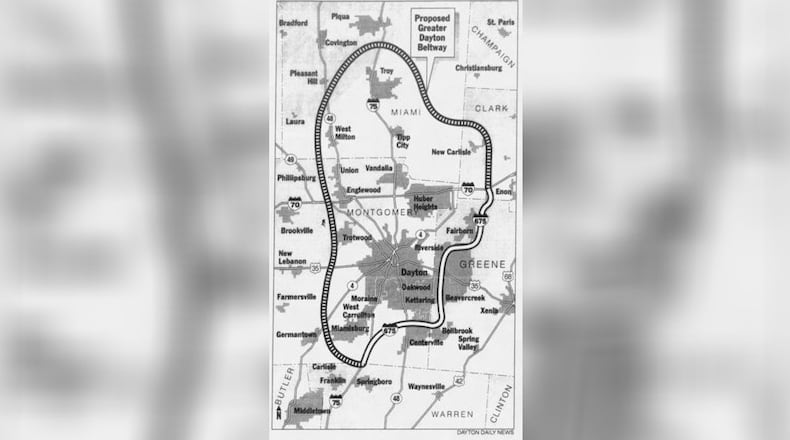Dayton was on its way to having its own loop when the eastern by-pass of Dayton, I-675, was completed in the late 1980s.
In 1993, plans were formed for the completion of what was known as the Greater Dayton Beltway, but those plans never happened.
Long-Range Transportation Plan
Major transportation plans for building a new highway can take decades to study, plan, fund and construct.
Under federal law, the region needs a long-range transportation plan to use federal transportation funds.
In 1992, the Miami Valley Regional Planning Commission developed a plan to complete the Greater Dayton Beltway with a western counterpart for I-675, to be named State Route 892, and a northern arc above I-70.
The MVRPC was a group of about 40 people that included a variety of elected officials from Montgomery, Miami and Greene counties, representatives from the Ohio Department of Transportation and the RTA, along with several prominent business leaders.
The timeline for their plan called for the highway to be built 15-20 years in the future.
Eastern beltway (I-675)
The I-675 project was first proposed in the 1950s as a beltway around the city, but officials later said traffic and population projections did not warrant construction of the western side.
In 1979, the Miami Valley Regional Planning Commission submitted a report to President Jimmy Carter’s administration recommending the approval of I-675, provided nine actions were taken by area businesses and governments to lessen adverse impacts on Dayton, minorities and low-income residents. Those recommended mitigating steps mostly included distributing fair housing across the region.
Credit: Jim Noelker
Credit: Jim Noelker
The Carter administration approved the construction of I-675, but only to U.S. Route 35. In 1981, the Reagan administration approved the continuation of I-675 to a connection with Interstate 75 in Miami Twp.
After a long and controversial journey, construction of I-675 was completed in the late 1980s.
Western beltway
In 1992, members of the Miami Valley Regional Planning Commission’s Transportation Committee identified the beltway as their most important undertaking to guide transportation development for the next 20 years.
As proposed, the 23.7-mile, four-lane divided highway would be built to interstate highway standards. It would extend from I-75 at the Warren County line, west to Ohio 4 and then north to connect I-70 near the Ohio 49 interchange.
However, Dayton planners representing the city questioned the need for the highway, citing population and job estimates generated for the plan. The estimates indicated there wasn’t likely to be enough growth over the next 20 years to justify it.
The Dayton planners and a local environmental group said the project would just redistribute the business and population that now existed, much as I-675 did. Dayton City Commission remained silent.
Those for it ranked the beltway as by far the most important undertaking to strengthen the region’s economy.
They said it would increase development, as the I-675 eastern beltway did, and would decrease congestion on I-75 and I-70.
The major resistance came from rural residents in the townships and some Dayton residents and officials. They questioned the need for the road and were concerned about likely negative effects on their communities.
The Miami Valley Regional Planning Commission ultimately dropped the Greater Dayton Beltway from its long-range plan in 2003.
Northern beltway
The northern portion of the beltway never had much of a chance.
The northern beltway loop was to be from I-70 moving into Miami County, where it would meet I-75 between Troy and Piqua and then continue southeast beyond New Carlisle to connect with I-675 at the I-70 interchange.
In November 1993, the Ohio Department of Transportation told the Miami Valley Regional Planning Commission that after preliminary review it found no demonstrated need for that portion of the proposed beltway in the 20-year time frame and that financing was not available for designing and building it.
“We understand and accept the state’s finding the northern part of the beltway isn’t justified within the next 20 years and fiscal constraints will prevent it advancing,” Miami County Commissioner Arthur Haddad said at the time.
About the Author





